Ha Giang, the northernmost province of Vietnam, is a land of majestic landscapes, with towering mountains, winding rivers, and the vibrant cultures of ethnic minority groups. While Ha Giang is known for its spectacular scenery, it also boasts unique culinary treasures that leave a lasting impression on visitors. Among its specialties, Bỗng fish stands out as a cherished delicacy, renowned for its exceptional taste and cultural significance.
In this article, we’ll delve deeper into the distinctiveness of Bỗng fish in Ha Giang, its importance in the local lifestyle, and the diverse culinary experiences it offers.
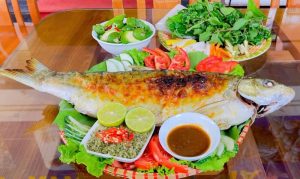
Nội dung bài viết
What is Bong Fish?
Bỗng fish (Cyprinidae) is a type of freshwater fish that thrives in clear, fast-flowing streams and rivers. Known for its ability to adapt to rocky riverbeds and cold water, the fish is mainly found in remote, unpolluted areas, making it a rare and precious delicacy.
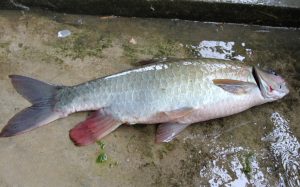
This species has a streamlined body, small scales, and flesh that is firm and slightly pinkish. What sets bong fish apart is its naturally sweet flavor and low fat content, making it not only delicious but also a healthy choice. Its high protein content, along with essential vitamins and minerals, has made it a staple in the diet of the people of Ha Giang for generations.
Why is Bong Fish Special in Ha Giang?
- Pristine Natural Environment
Ha Giang’s rugged geography, characterized by limestone mountains and cool streams, provides the perfect ecosystem for bong fish. Unlike other freshwater species, bong fish requires a habitat that is clean, oxygen-rich, and constantly moving, which the region’s streams and rivers naturally provide. - Unique Taste and Texture
Bỗng fish in Ha Giang has a mild, sweet taste with firm and dense flesh. The strong currents in which they live force the fish to be lean and muscular, enhancing their natural flavor. Unlike other freshwater fish, Bỗng fish has no muddy or fishy odor, even when cooked simply. - Sustainable Fishing Practices
The people of Ha Giang have long practiced sustainable fishing methods to ensure the preservation of this precious resource. Traditional tools such as fish traps, hooks, and nets are used, and fishing is often done seasonally to maintain ecological balance. These age-old practices reflect the community’s respect for nature and their dependence on it for sustenance.
How is Bong Fish Prepared?
Ha Giang’s cuisine emphasizes freshness and simplicity, and bong fish is no exception. Whether grilled, steamed, fried, or cooked in soups, this fish lends itself to a variety of cooking styles while retaining its natural sweetness.
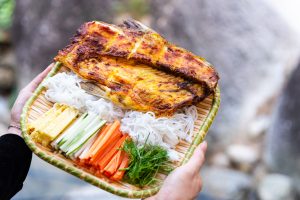
Here are some standout dishes made from Bỗng fish:
- Grilled Bỗng fish with Salt and Chili
This rustic dish is a favorite among locals and visitors alike. The fish is cleaned and marinated with coarse salt, crushed chili, and lime juice before being grilled over an open flame. The result is a golden-brown, crispy exterior with juicy, aromatic flesh. Served with wild vegetables and a lime-pepper dipping sauce, it’s a true taste of Ha Giang. - Steamed Bỗng fish with Herbs
Steaming preserves the natural sweetness of the fish while infusing it with the fragrance of forest herbs such as lime leaves, perilla, and ginger. The simplicity of this dish highlights the fish’s clean, fresh flavor, making it a popular choice for health-conscious diners. - Bong Fish Hotpot
A perfect dish for the region’s cold weather, bong fish hotpot combines the fish’s sweetness with sour and spicy flavors from tamarind, lemongrass, and fresh chili. Served alongside an array of fresh vegetables and vermicelli noodles, the hotpot is a warming and satisfying meal for families or groups. - Fried Bong Fish with Turmeric
Slices of bong fish are coated with turmeric powder and deep-fried until golden. This dish is not only visually appealing but also carries the earthy aroma of turmeric, which complements the fish’s sweetness. - Sour Bong Fish Soup
A light and refreshing soup, this dish features bong fish cooked with taro stems, tomatoes, and water celery. The addition of tamarind juice or fermented rice adds a tangy twist, making it a favorite during summer months.
Cultural Significance of Bong Fish
For the people of Ha Giang, Bỗng fish is more than just a source of sustenance—it is a symbol of their connection to nature and their ancestral traditions.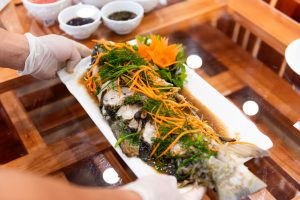
- A Dish of Hospitality
During festive occasions, weddings, or when welcoming guests, bong fish dishes are often served as a gesture of respect and hospitality. Preparing bong fish reflects the host’s effort and care, as catching and cooking this fish requires both skill and time. - A Source of Livelihood
Many households in Ha Giang rely on fishing for bong fish to support their families. This practice not only sustains the local economy but also helps preserve the cultural identity of the region. Markets in towns like Dong Van and Meo Vac are bustling with the trade of fresh Bỗng fish, which often commands a premium price due to its rarity. - A Culinary Tradition
The preparation of bỗng fish is deeply rooted in Ha Giang’s culinary heritage. Recipes are often passed down through generations, with each family adding their own twist to the dishes. For locals, eating Bỗng fish is not just about nourishment—it’s a way to celebrate their culture and identity.
Where to Try Bong Fish in Ha Giang
Visitors to Ha Giang can enjoy Bỗng fish at various local eateries and restaurants. Some popular spots include:
- Pho Co Dong Van Restaurant: Known for its authentic and flavorful bong fish hotpot.
- Bo Suoi Eatery in Yen Minh: Famous for grilled bong fish served with wild vegetables.
- Tam Son Restaurant: Offers a variety of bong fish dishes in a cozy, rustic setting.
For those seeking a more immersive experience, many homestays in Ha Giang also serve local specialty as part of their traditional meals, allowing guests to savor the flavors of the region in a familial atmosphere.
Tips for Enjoying Bong Fish
- Freshness is Key: Always choose dishes made from freshly caught bong fish to experience its full flavor and texture.
- Pair with Local Rice Wine: Ha Giang’s homemade rice wine perfectly complements the sweet, rich taste of bong fish dishes.
- Eat Like a Local: Try eating this delicacy with wild vegetables and dipping sauces for an authentic taste of Ha Giang’s culinary traditions.
Conclusion
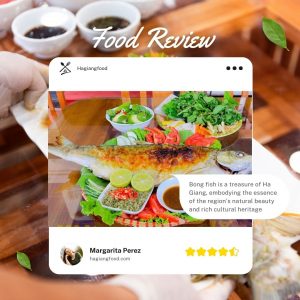
Bỗng fish is a treasure of Ha Giang, embodying the essence of the region’s natural beauty and rich cultural heritage. Its unique flavor, combined with the traditional methods of preparation, makes it a must-try for anyone visiting this northern province.
Whether enjoyed as part of a family meal, a festive celebration, or a simple countryside lunch, Bỗng fish offers a glimpse into the heart and soul of Ha Giang’s people and their way of life.
If you’re planning a trip to Ha Giang, don’t miss the opportunity to taste bong fish. It’s more than just a meal—it’s an unforgettable culinary journey.
_____________________________________________________________________________________






HOT NEWS
KỶ NIỆM 50 NĂM NGÀY GIẢI PHÓNG MIỀN NAM – THỐNG NHẤT ĐẤT NƯỚC (30/4/1975 – 30/4/2025)
Tri Ân 50 Năm Ngày Giải Phóng Miền Nam 30/4 [...]
[...]
Massage Lạc Tiên – Ngủ Ngon
Massage Lạc Tiên – Ngủ Ngon Liệu pháp Massage bấm huyệt [...]
Tập luyện sau chấn thương: Những điều nên và không nên làm
Tập luyện sau chấn thương: Những điều nên và không nên [...]
Bài tập Yoga giảm stress giúp giảm stress hiệu quả sau 15 phút
Bài tập Yoga giảm stress giúp giảm stress hiệu quả sau [...]
6 Điều bạn chưa biết về massage cổ vai chuyên sâu tại Spa
6 điều bạn chưa biết về massage cổ vai chuyên sâu [...]
Massage Đầu & Mặt Thư Giãn Tại Hà Giang
Massage Đầu & Mặt Thư Giãn Gần Đây Tại Hà Giang [...]